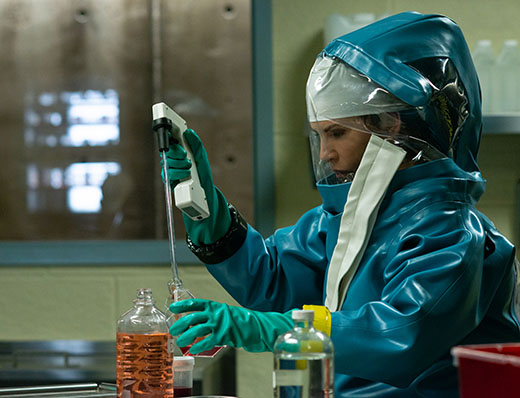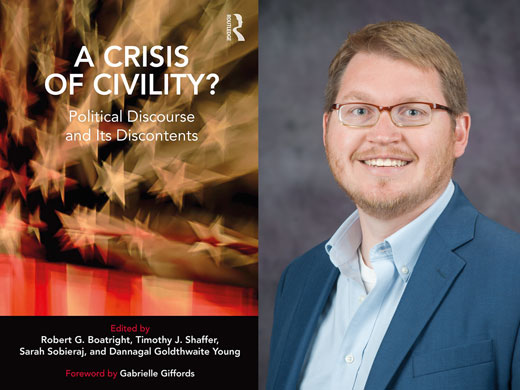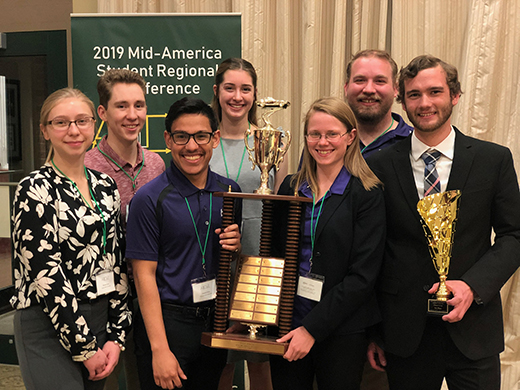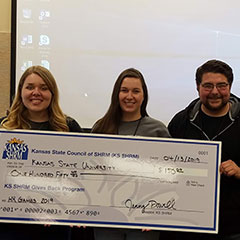04/24/19
K-State Current - April 24, 2019
K-State Current is a weekly news update for the Kansas Board of Regents to apprise the Regents on a few of the many successes and achievements made by K-State faculty, staff and students.

K-State News
Kansas State University researchers send mice into space for immune system studies
Forty mice with Kansas State University ties were launched to the International Space Station April 17 to learn more about human health.
A team of researchers that includes Stephen Keith Chapes, Kansas State University professor of biology and interim director of the university's Johnson Cancer Research Center, is studying the impact of space flight on the immune system's ability to respond to things that make people sick.
Space flight causes changes to the immune system. One of the most important components of that system is the B cell. B cells make antibody molecules that are secreted into the body to gather up and help rid the body of harmful substances, including bacteria, fungi and viruses.
The TARBIS project — Tetanus Antibody Response by B cells in Space — will determine if mice are able to mount the same kind of B-cell response they do on Earth. Chapes and his students at Kansas State University are collaborating with Loma Linda University researchers led by Michael Pecaut.
"We are very excited for this flight, having spent the past five years preparing for it," Chapes said. "The astronauts will now be our hands in space to perform the experiment."
The study also will investigate whether the diversity of the B-cell population is affected by the space environment. This unique study involves injecting the mice with Tetanus toxoid while on the International Space Station. That is the same type of vaccine humans get when cut or scraped by contaminated objects like dirty nails.
According to Chapes, this project is Earth-relevant because space changes the body, making it function as if it were older.
"Space offers an excellent model of aging, as it demonstrates bone, muscle and immune system deterioration, as well as increased susceptibility to disease," Chapes said.
This study also will test a drug for its ability to reverse some of the deterioration. Since immunocompromised individuals are more susceptible to infections and the development of cancer, this experiment will provide some insights on treating those conditions.
Chapes' group is not new to the space environment. They have had experiments on 13 different Space Shuttle missions.
NASA's website provides information about the TARBIS project specifically and about this NASA mission to the International Space Station.
Two Kansas State University veterinarians and leaders — Nancy and Jerry Jaax — and their response to an Ebola-related outbreak have inspired the upcoming National Geographic limited series, THE HOT ZONE.
Kansas State University will host a May 7 advance screening of the premiere of THE HOT ZONE followed by a panel discussion with the real-life subjects of the series, Nancy and Jerry Jaax, along with the showrunners, writers and executive producers Brian Peterson and Kelly Souders. The event, also sponsored by K-State Student Union Program Council, will be at 7 p.m. on Tuesday, May 7, in Forum Hall in the K-State Student Union. Kansas State University President Richard Myers will provide introductory remarks.
The event is free and open to the public. The advance screening will be the first screening following the show’s debut at the Tribeca Film Festival.
The six-part limited series premieres on National Geographic at 8 p.m. on Monday, May 27, and will air over three nights. Julianna Margulies plays Lt. Col. Nancy Jaax and Noah Emmerich plays Lt. Col. Jerry Jaax.
Watch the official trailer for National Geographic's THE HOT ZONE.
"Nancy and Jerry Jaax are renowned leaders, scientists and veterans," Kansas State University President Richard Myers said. "We are honored that National Geographic is telling their story through THE HOT ZONE and we want to recognize these two K-Staters for their bravery and heroic research contributions. Leaders like Nancy and Jerry Jaax are true examples of what makes K-State the 'Silicon Valley for biodefense.'"
THE HOT ZONE is based on the 1994 bestseller by Richard Preston and is inspired by the true story of the arrival of Ebola on U.S. soil in 1989 in Reston, Virginia.
The story involves two prominent Kansas State University leaders: Nancy and Jerry Jaax. Both graduated with veterinary medicine degrees from the university and served in medical defense with the U.S. Army, during which time they became involved in the events depicted in the series.
Following the events of 1989 and after stellar military careers, Jerry and Nancy returned to Manhattan. Jerry joined the university and served in a prominent research leadership position to further the university's biodefense mission. Nancy participated in innumerable infectious disease initiatives at the university.
Both Jerry and Nancy played important roles in the development of Kansas State University's biocontainment facility called the Biosecurity Research Institute, or BRI, at Pat Roberts Hall. Nancy inspired the need for a training lab based on her experience with Ebola. They also assisted in winning the national competition for the National Bio and Agro-defense Facility, or NBAF, which is under construction north of the university's Manhattan campus. Once NBAF becomes operational in 2022-2023, it will be America's foremost animal disease research facility.
To coincide with National Geographic’s THE HOT ZONE and celebrate the work of Nancy and Jerry, Kansas State University is organizing several events in Manhattan and Olathe in the coming weeks. Details will be posted at k-state.edu/hotzone.
 In this photo from THE HOT ZONE, Nancy Jaax, played by Julianna Margulies, works in her pathology lab. Photo credit: National Geographic
In this photo from THE HOT ZONE, Nancy Jaax, played by Julianna Margulies, works in her pathology lab. Photo credit: National Geographic
 In this photo from THE HOT ZONE, Jerry Jaax, played by Noah Emmerich, provides instructions to a team of researchers. Photo credit: National Geographic
In this photo from THE HOT ZONE, Jerry Jaax, played by Noah Emmerich, provides instructions to a team of researchers. Photo credit: National Geographic
K-State Faculty Highlights
No time to lose: Historic examples of civility may help today's civil discourse, according to new book
 A look at the past may help ordinary people improve civility, according to Kansas State University’s Timothy J. Shaffer, co-editor/author of the book, "A Crisis of Civility?: Political Discourse and Its Discontents" from Routledge.
A look at the past may help ordinary people improve civility, according to Kansas State University’s Timothy J. Shaffer, co-editor/author of the book, "A Crisis of Civility?: Political Discourse and Its Discontents" from Routledge.
Receiving praise from former U.S. Rep. Gabrielle Giffords, former senator and Senate Majority Leader Tom Daschle and former news anchor Katie Couric, the book discusses the status of the nation's civility. Shaffer, assistant professor of communication studies and assistant director of the Institute for Civic Discourse and Democracy, wrote the chapter, "Enabling Civil Discourse: Creating Civic Space and Resources for Democratic Discussion." The chapter includes historical examples from the New Deal era in the 1930s and 1940s of how people were able to have difficult discussions about shared problems.
"When the rest of the world was falling to authoritarian leaders like Mussolini, the U.S. was wrestling with how to stay a democratic country," Shaffer said. "It was during this same time that institutions like Kansas State University became involved in a national project with the U.S. Department of Agriculture to cultivate civil discourse through citizen-centered discussion groups."
Shaffer said that many of the discussion topics were around contentious issues similar to today such as soil erosion, taxes and imports/exports, and differences in tensions between urban and rural communities. The group discussions provided space and resources for democratic conversations that helped shaped agriculture policy, encouraged civic adult education and increased public discussion. The discussions even covered problems like how to adjust to new societal advancements, such as the expansion of electricity into rural areas and the impact of mechanized farm equipment on the identity of the farmer.
"I think it's really important for us to remember that we've figured out how to navigate and deal with shifts before," Shaffer said. "One of the discussion guides talked about how some people in rural communities were upset after gravel roads were built because now people were flying by on their way to town and were no longer talking to others as they did when they traveled by horse and buggy."
The project used those discussions to create guides and training materials for civil discourse. The guides emphasized the importance of being able to get beyond the superficial understanding of issues. One of the historical guides discussed "how to create opportunities for people to learn to listen to and think through divergent views and cooperate in finding common ground" — a theme discussed throughout the whole book called intellectual humility.
"The way that we talk and think about civility is much more fundamentally rooted in this idea of how do we — in a practical way — live with one another," Shaffer said. "How do we engage each other in shared life, recognizing that we are going to have competing views, values and claims, yet at the end of the day, still co-exist?"
Shaffer said that while a civil society may be thought of as something that happens in government, it should be shaped by ordinary people who have perspectives and positions that merit public consideration. Looking at the historical examples like the USDA programs during the New Deal era sheds light on the possibility for cultivating democratic discussion, offers the resources for making it possible and explores the challenges that need to be overcome.
"We need to be able to engage with others while keeping in mind that we each have our own biases and assumptions literally walking in the door," Shaffer said. "I'd like to think about myself as being an informed citizen but I also need to listen deeply enough that I am receptive to having my mind changed no matter how deeply I feel about a position."
Shaffer has written numerous other articles and chapters on this topic and period, with a forthcoming book exploring the topic more extensively.
In addition to Shaffer, editors include Robert Boatright, professor of political science at Clark University and director of research at the National Institute for Civil Discourse at the University of Arizona; Sarah Sobieraj, associate professor of sociology at Tufts University; and Dannagal Goldthwaite Young, associate professor of communication at the University of Delaware.
Additional authors include Steven Bullock at Worcester Polytechnic Institute; Kevin Coe at the University of Utah; Giffords, the former congresswoman from Arizona; Lindsay Hoffman at the University of Delaware; Kate Kenski and Stephen Rains at the University of Arizona; Anthony Simon Laden at the University of Illinois at Chicago; Carolyn Lukensmeyer at the National Institute for Civil Discourse; Deborah Mower at the University of Mississippi; Ashley Muddiman at the University of Kansas; Deana Rohlinger at Florida State University; and Michael Wolf at Purdue University, Fort Wayne.
K-State Student News
ChemE Car team brings home top prize from regional competition
 For the third time in the past five years, the Kansas State University ChemE Car team took first place at the 2019 Mid-America Regional American Institute of Chemical Engineers Conference.
For the third time in the past five years, the Kansas State University ChemE Car team took first place at the 2019 Mid-America Regional American Institute of Chemical Engineers Conference.
This year's event, hosted by Missouri University of Science and Technology April 13 in Rolla, Missouri, saw teams from Kansas, Iowa, Oklahoma, Missouri, Arkansas and Nebraska compete with 14 different cars.
The ChemE Car team of students from Kansas State University designed and constructed its winning entry, Wildcat Workout, powered by a chemical energy source to safely carry a specified load over a given distance and stop. Chemical sources could be from homemade batteries, biological catalysts, pressure reactions, thermodynamic reactions or other related choices. Each team's entry had to pass a safety inspection to prove there were no chemical, mechanical, electrical or pressure hazards.
"The competition is not about having the fastest, biggest or longest lasting car," said team captain, Katharine Kellogg, senior in chemical engineering from Colorado Springs, Colorado, "but is about having the best control over your reaction so you can make the car go an exact distance."
Wildcat Workout was powered by an acid-base reaction between potassium carbonate and citric acid, creating carbon dioxide and pressurizing the system. A solenoid, controlled by an Arduino — an open-source electronic prototyping platform — released some of the carbon dioxide into an artificial muscle, causing it to contract. The muscle was connected to the axle of the car enabling each contraction to move the vehicle forward.
"To our knowledge, our entry used the first pneumatic muscle in the competition," Kellogg said, "and our car was also unique because a large portion of its chassis was 3D printed."
Team advisers, faculty from the Tim Taylor Department of Chemical Engineering, are Keith Hohn, Jennifer Anthony and Andrew Duncan.
In addition to Kellogg, team members, all chemical engineering majors, include the following:
Joseph Hewitt, senior, Hutchinson; David Alex Ortiz, sophomore, Lansing; Jack Gerhold, senior, and Rachel Berland, both freshmen and both from Olathe; Denea Clark, freshman, Wichita; and Dean Bennett, senior, Union Bridge, Maryland.
K-State team takes second place at Kansas Society of Human Resource Management HR Games
Three student teams from the College of Business Administration recently traveled to Fort Hays State University to participate in the 2019 Kansas Society of Human Resource Management, or SHRM, HR Games.
The SHRM HR Games pits teams of students from universities around the state is a Jeopardy-style competition in human resource-related categories. Thirteen teams competed in this year's games.
Two of the K-State teams made it to the semifinals of the competition, with the team comprised of seniors in management Timothy Lillis, Macy Bruton and Makayla Crow advancing to the final round and ultimately placing second overall with a $150 prize. Also competing for K-State were Kylee Fink, senior in management; Fatou Faburay, junior in management; Nicole Bolte, senior in management; Hannah Valentine, junior in management; Hannah Sultz, junior in management; and Lydia Goering, sophomore in business.
The 2019 SHRM Student Summit and HR Games provided opportunities for students, student chapter advisors, faculty members and HR professionals to connect. Attendees heard from a variety of speakers, and had the opportunity to network with local HR practitioners and other students. The event is designed to enhance student perspectives on what it means to be a member of the HR community and prepare young professionals to advance both personally and professionally.
The 2020 Kansas SHRM Student Summit and HR Games will be hosted at Kansas State University.